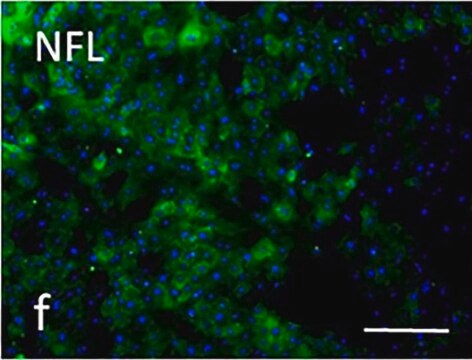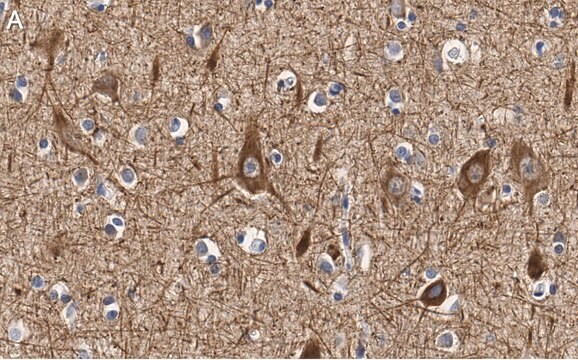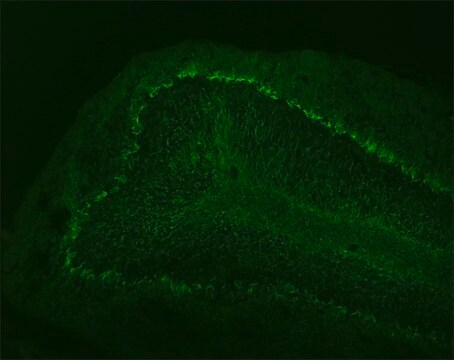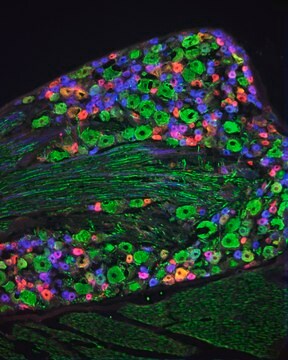AB1987
Anti-Neurofilament M (145 kDa) Antibody, CT
serum, Chemicon®
Synonim(y):
Anti-NEF3
About This Item
Polecane produkty
pochodzenie biologiczne
rabbit
Poziom jakości
forma przeciwciała
serum
rodzaj przeciwciała
primary antibodies
klon
polyclonal
reaktywność gatunkowa
reptile, chicken, rat, quail, pig, human, mouse, bovine, rabbit
producent / nazwa handlowa
Chemicon®
metody
immunocytochemistry: suitable
immunohistochemistry (formalin-fixed, paraffin-embedded sections): suitable
western blot: suitable
numer dostępu NCBI
numer dostępu UniProt
Warunki transportu
dry ice
docelowa modyfikacja potranslacyjna
unmodified
informacje o genach
bovine ... Nefm(281347)
chicken ... Nefm(396206)
human ... NEFM(4741)
mouse ... Nefm(18040)
rabbit ... Nefm(100009343)
rat ... Nefm(24588)
Opis ogólny
Specyficzność
Immunogen
Zastosowanie
A 1:200 dilution of a previous lot was used in Immunohistochemistry.
Staining is not affected by neurofilament phosphorylation. Optimal Staining With TE Buffer, pH 9.0, Epitope Retrieval: Human Cerebellum
Immunohistochemistry(paraffin):
Optimal working dilutions must be determined by end user.
Neuroscience
Neurofilament & Neuron Metabolism
Neuronal & Glial Markers
Jakość
Western Blot: 1:1000 dilution of this lot detected Neurofilament M on 10 μg of mouse brain lysates..
Opis wartości docelowych
Postać fizyczna
Przechowywanie i stabilność
Handling Recommendations:
Upon receipt, and prior to removing the cap, centrifuge the vial and gently mix the solution. Aliquot into microcentrifuge tubes and store at -20°C. Avoid repeated freeze/thaw cycles, which may damage IgG and affect product performance.
Komentarz do analizy
Rat enteric neurons, rat spinal cord tissue Brain, Peripheral Nerve
Inne uwagi
Informacje prawne
Oświadczenie o zrzeczeniu się odpowiedzialności
Nie możesz znaleźć właściwego produktu?
Wypróbuj nasz Narzędzie selektora produktów.
polecane
Kod klasy składowania
10 - Combustible liquids
Klasa zagrożenia wodnego (WGK)
WGK 1
Temperatura zapłonu (°F)
Not applicable
Temperatura zapłonu (°C)
Not applicable
Certyfikaty analizy (CoA)
Poszukaj Certyfikaty analizy (CoA), wpisując numer partii/serii produktów. Numery serii i partii można znaleźć na etykiecie produktu po słowach „seria” lub „partia”.
Masz już ten produkt?
Dokumenty związane z niedawno zakupionymi produktami zostały zamieszczone w Bibliotece dokumentów.
Nasz zespół naukowców ma doświadczenie we wszystkich obszarach badań, w tym w naukach przyrodniczych, materiałoznawstwie, syntezie chemicznej, chromatografii, analityce i wielu innych dziedzinach.
Skontaktuj się z zespołem ds. pomocy technicznej






